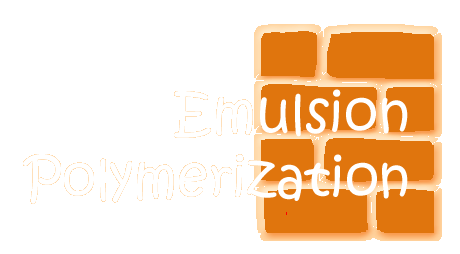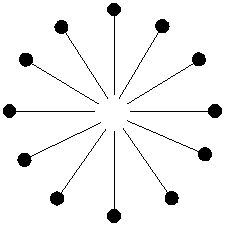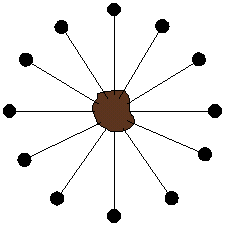

The definition for emulsion is: "A stable colloidal suspension as milk, consisting of an immiscible liquid dispersed and held in another liquid by a substance called an emulsifier".
In order to understand emulsion polymerization and emulsifiers, we’ve got to understand how soap works. Yes, soap! If you already know how soap works and have Grandma’s recipe for lye soap, click here to get to the part on emulsion polymerization. If you’re curious, then read on!
Soap molecules suffer from a multiple personality disorder, but their dual personalities are always apparent. A soap, or surfactant as it is referred to in emulsion polymerizations, has two ends of different solubility. One end, termed the tail, is a long hydrocarbon that is soluble in nonpolar, organic compounds. The other, the head, is often a sodium or potassium salt, which is water soluble. The water soluble salt can be the salt of a carboxylic acid or sulfonic acid. The technical term for the chemical display of "dual personalities" is amphipathic.

One soap molecule isn’t much good to you. But when you get a whole bunch of ‘em together, neat stuff starts to happen. At a certain concentration in water, soap molecules congregate and form micelles. Scientists have an apt (if not original) name for this called the critical micelle concentration, or CMC for short. Don’t let the scientists fool you; they’re really doin’ the hokey pokey, tails inward.

Any dirt, grease, or grime that you happen to have on your hands is most likely organic and looks like this:

When you wash your hands with soapy water the hokey pokey party really gets goin’. The jubilant dirt particle jumps right in the middle where it's pretty happy. It doesn't want to get out so it stays dissolved in the organic tails of the micelle.

Now the dirt is dissolved in the micelle, and the micelle is dissolved in water, and...Voila! With copious amounts of water, you can wash everything down the drain.
Party Pooper.
Now a question for you: Why is it difficult to take a bath in the ocean?
In an emulsion polymerization, the soap, or surfactant, is dissolved in water until the critical micelle concentration (CMC) is reached. The interior of the micelle provides the site necessary for polymerization. A monomer (like styrene or methyl methacrylate) and a water soluble free radical initiator are added and the whole batch is shaken or stirred (sorry, James Bond). Emulsion polymerizations are always performed free radically. Anionic and cationic chain ends would be rapidly quenched by the water. The product of an emulsion polymerization is called a latex; does the term "latex paint" ring a bell?
Once everything is thrown in the pot, the monomer can be found in three different places. First, it can be in large monomer droplets floating around aimlessly in the water. Second, some of the monomer may be dissolved in the water, but this is unlikely. Remember, organic monomers like styrene and methyl methacrylate are hydrophobic. Lastly, the monomer may be found in micelles, which is exactly where we want it. Now look back at the definition at the beginning of this page. The immiscible liquid is the hydrophobic monomer, the mother liquor is water, and the emulsifier is soap.
Initiation takes place when an initiator fragment migrates into a micelle and reacts with a monomer molecule. Water soluble initiators, such as peroxides and persulfates, are commonly used (This also prevents polymerization in the big monomer droplets). Once polymerization starts, the micelle is referred to as a particle. Polymer particles can grow to extremely high molecular weights, especially if the initiator concentration is low. That makes the radical concentration and the rate of termination low as well. Sometimes a chain transfer agent is added to the mix to keep the molecular weight from getting too high.
Monomer migrates from the large monomer droplets to the micelles to sustain polymerization. On average, there is one radical per micelle. Because of this, there isn't much competition for monomer between the growing chains in the particles, so they grow to nearly identical molecular weights and the polydispersity is very close to one. Practically all the monomer is consumed in emulsion polymerizations, meaning the latex can be used without purification. This is important for paints and coatings. Just add some color to the latex, pour it into a can, and it's ready to use.
Here's the neat aspect of emulsion polymerization: each micelle can be considered as a mini bulk polymerization. Unlike traditional bulk polymerizations there is no unreacted monomer leftover, and no thermal "hot spots" form. In bulk polymerizations (no solvent, just monomer and initiator), thermal hot spots cause degradation and discoloration and chain transfer broadens the molecular weight distribution. An increase in temperature sometimes cause the rate of polymerization to increase explosively. The water here acts as a heat sink for all those mini reactors and keeps them from blowing up! Pyromaniacs don't do emulsion polymerizations.
Now this is cool too: The rate of polymerization is the same as the rate of disappearance of monomer. Monomer disappears faster when there are more particles. In order to have more particles there must be more micelles. If the soap sud concentration is increased, this ought to give us more micelles. Now suppose the concentration of initiator is left the same. This will give us more particles and less radicals. What this means is the number of radicals per micelle drops below one. In other words, the rate of termination will be low since there are less radicals. WHEW!
So the end result is this: decreasing the initiator concentration increases molecular weight and rate of polymerization! This is completely opposite from bulk and solution polymerization. To increase the rate of polymerization for those you have to heat the reaction or increase the initiator concentration, both of which increase the rate of termination and lower the molecular weight.
Sounds neat, but is it useful? Sure is. Poly(vinyl acetate),polychloroprene, polymethacrylates, poly(vinyl chloride), polyacrylamide, and copolymers of polystyrene, polybutadiene, and polyacrylonitrile are made commercially by emulsion polymerization.
You've waded through the muck to get this far, unless, of course, you skipped down to the bottom to see if anything cool was here. The set-up now gets paid off with this handy-dandy, easy to decipher table that lists the good and the bad (and, believe me, it's all ugly!).
| Polymerization Process | The Good | The Bad |
| Bulk | Only monomer is present--no extra stuff, High molecular weights | Thermal hotspots, High viscosity, Unreacted monomer present |
| Solution | Easy temperature control, Control of molecular weight | Must remove solvent, Chain transfer to solvent |
| Emulsion | All monomer reacts, Latex is usable "as is", Thermally controllable, Can make low Tg materials, Low viscosity | Presence of surfactant may cause water sensitivity |
Odian, G., "Principles of Polymerization" 3rd Ed., John Wiley and Sons, Inc., New York, 1991.
Rosen, S.L., "Fundamental Principles of Polymeric Materials" 2nd Ed., John Wiley and Sons, Inc., New York, 1993.

|
Return to Level Four Directory |

|
Return to Macrogalleria Directory |
